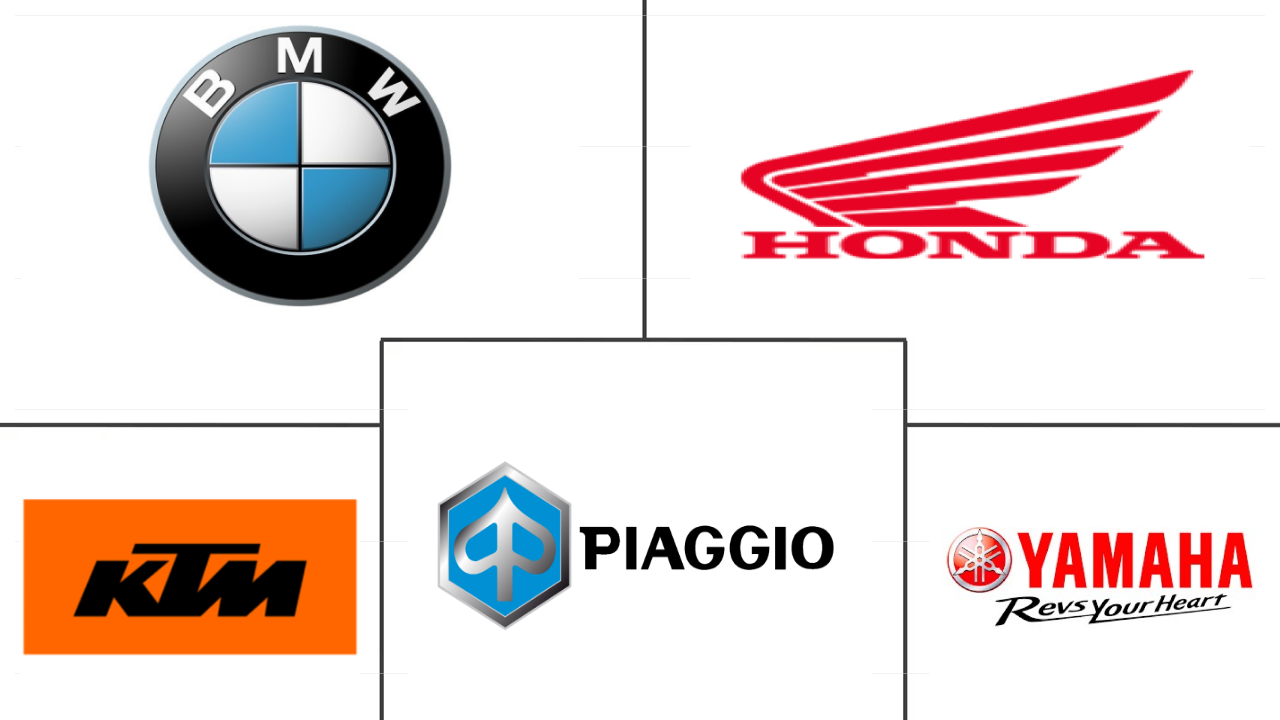Market Size of europe two-wheeler Industry
|
|
Study Period | 2017 - 2030 |
|
|
Market Size (2024) | USD 7.74 Billion |
|
|
Market Size (2030) | USD 18.05 Billion |
|
|
Largest Share by Propulsion Type | ICE |
|
|
CAGR (2024 - 2030) | 15.15 % |
|
|
Largest Share by Country | France |
Major Players |
||

|
||
|
*Disclaimer: Major Players sorted in no particular order |
Europe Two-Wheeler Market Analysis
The Europe Two-Wheeler Market size is estimated at 7.74 billion USD in 2024, and is expected to reach 18.05 billion USD by 2030, growing at a CAGR of 15.15% during the forecast period (2024-2030).
7.74 Billion
Market Size in 2024 (USD)
18.05 Billion
Market Size in 2030 (USD)
8.23 %
CAGR (2017-2023)
15.15 %
CAGR (2024-2030)
Largest Segment by Propulsion Type
72.96 %
value share, ICE, 2023
ICE two-wheelers dominate due to their affordability, widespread availability, and well-established refueling infrastructure across Europe.
Fastest-growing Segment by Propulsion Type
30.14 %
Projected CAGR, Hybrid and Electric Vehicles, 2024-2030
E2W are growing rapidly due to strong government support for sustainable transportation, extensive charging infrastructure, and increasing consumer preference for eco-friendly vehicles.
Largest Segment by Country
22.87 %
value share, France, 2023
France leads due to its strong automotive industry, extensive road network, and high consumer demand for efficient two-wheeler transportation in both urban and rural areas.
Leading Market Player
15.40 %
market share, Honda Motor Co.,Ltd., Ltd.

Honda Motor Co. Ltd. leads Europe's two-wheeler market due to its wide range of high-quality products, strong brand reputation, and extensive distribution network.
Second leading Market Player
10.90 %
market share, Yamaha Motor Company Limited, 2023

Yamaha Moto is the second leading player in Europe's two-wheeler market due to its extensive product range, trusted quality, and strong dealership network.
The European two-wheeler market's steady growth signifies an electrification and sustainability shift driven by tech advancements, policies, and changing consumer preferences
- In 2023, the European market for two-wheelers exhibited a growth pattern, with sales totaling 1,256,184 units, indicating an increase from the previous year's 1,188,468 units. This growth reflected an expanding interest in two-wheelers as both a primary and secondary mode of transportation, fueled by urbanization, the search for more sustainable commuting options, and the increased appeal of two-wheelers for leisure activities.
- The European market's progression is significantly influenced by the surge in hybrid and electric two-wheeler adoption. This shift is supported by a combination of factors, including stringent environmental regulations, government incentives aimed at promoting cleaner modes of transportation, and growing consumer consciousness towards reducing carbon footprints. These elements, coupled with advancements in electric two-wheeler technology—such as improved battery life, shorter charging times, and enhanced performance—are making electric options increasingly viable and attractive to a broader segment of consumers.
- From 2024 to 2030, the forecasted data indicated a steady increase in two-wheeler sales across Europe, with projections showing that sales could reach 1,730,220 units by 2030. This sustained growth trajectory underscores the enduring appeal of two-wheelers as a flexible, efficient, and sustainable mode of transportation. The continued rise in electric two-wheeler sales is expected to significantly contribute to this growth, reflecting a broader trend towards electrification in the transportation sector.
Manufacturers are investing in research and development to introduce more efficient, safer, and smarter two-wheelers with advancements in battery technology, autonomous driving features, and connectivity
- The European two-wheeler market has been witnessing significant growth and transformation, driven by a combination of technological advancements, changing consumer preferences, and increasing environmental concerns. The market encompasses a wide range of vehicles, including motorcycles, scooters, mopeds, and electrically powered two-wheelers. The surge in demand for electric two-wheelers, in particular, reflects the region's growing commitment to sustainable transportation solutions. This shift is further supported by government incentives, stricter emission regulations, and an expanding infrastructure for electric vehicles, making electric two-wheelers an increasingly attractive option for consumers.
- Consumer preferences in Europe have been evolving, with a noticeable trend toward urban mobility solutions that offer convenience, affordability, and reduced environmental impact. Two-wheelers, especially scooters and mopeds, have become popular urban transport options due to their ability to navigate through traffic more efficiently than cars, lower operating costs, and ease of parking. This trend is complemented by the growing popularity of ride-sharing platforms and rental services for two-wheelers, which offer flexible and cost-effective mobility solutions without the need for ownership. Additionally, the advent of smart connectivity features in two-wheelers, such as GPS navigation, anti-theft systems, and smartphone integration, has enhanced the riding experience, making them more appealing to tech-savvy consumers.
Europe Two-Wheeler Industry Segmentation
Hybrid and Electric Vehicles, ICE are covered as segments by Propulsion Type. Austria, Belgium, Czech Republic, Denmark, Estonia, France, Germany, Ireland, Italy, Latvia, Lithuania, Norway, Poland, Russia, Spain, Sweden, UK, Rest-of-Europe are covered as segments by Country.
- In 2023, the European market for two-wheelers exhibited a growth pattern, with sales totaling 1,256,184 units, indicating an increase from the previous year's 1,188,468 units. This growth reflected an expanding interest in two-wheelers as both a primary and secondary mode of transportation, fueled by urbanization, the search for more sustainable commuting options, and the increased appeal of two-wheelers for leisure activities.
- The European market's progression is significantly influenced by the surge in hybrid and electric two-wheeler adoption. This shift is supported by a combination of factors, including stringent environmental regulations, government incentives aimed at promoting cleaner modes of transportation, and growing consumer consciousness towards reducing carbon footprints. These elements, coupled with advancements in electric two-wheeler technology—such as improved battery life, shorter charging times, and enhanced performance—are making electric options increasingly viable and attractive to a broader segment of consumers.
- From 2024 to 2030, the forecasted data indicated a steady increase in two-wheeler sales across Europe, with projections showing that sales could reach 1,730,220 units by 2030. This sustained growth trajectory underscores the enduring appeal of two-wheelers as a flexible, efficient, and sustainable mode of transportation. The continued rise in electric two-wheeler sales is expected to significantly contribute to this growth, reflecting a broader trend towards electrification in the transportation sector.
| Propulsion Type | |
| Hybrid and Electric Vehicles | |
| ICE |
| Country | |
| Austria | |
| Belgium | |
| Czech Republic | |
| Denmark | |
| Estonia | |
| France | |
| Germany | |
| Ireland | |
| Italy | |
| Latvia | |
| Lithuania | |
| Norway | |
| Poland | |
| Russia | |
| Spain | |
| Sweden | |
| UK | |
| Rest-of-Europe |
Europe Two-Wheeler Market Size Summary
The European two-wheeler market is experiencing significant growth, driven by a shift towards sustainable transportation solutions and technological advancements. The market encompasses a diverse range of vehicles, including motorcycles, scooters, mopeds, and electric two-wheelers. The increasing adoption of electric two-wheelers is a key trend, supported by stringent environmental regulations, government incentives, and advancements in electric vehicle technology. This shift is making electric options more viable and appealing to consumers, reflecting a broader trend towards electrification in the transportation sector. The market's expansion is further fueled by urbanization and the growing popularity of two-wheelers as efficient and flexible urban mobility solutions.
Consumer preferences in Europe are evolving, with a noticeable trend towards urban mobility solutions that offer convenience, affordability, and reduced environmental impact. Two-wheelers, particularly scooters and mopeds, are becoming popular due to their ability to navigate traffic efficiently, lower operating costs, and ease of parking. The rise of ride-sharing platforms and rental services for two-wheelers also contributes to this trend, providing flexible and cost-effective mobility solutions. Additionally, smart connectivity features in two-wheelers, such as GPS navigation and smartphone integration, enhance the riding experience, appealing to tech-savvy consumers. The market is moderately consolidated, with major players like BMW Motorrad, Honda Motor Co., Ltd., KTM Motorcycles, Piaggio & C. SpA, and Yamaha Motor Company Limited leading the industry.
Europe Two-Wheeler Market Size - Table of Contents
-
1. MARKET SEGMENTATION (includes market size in Value in USD and Volume, Forecasts up to 2030 and analysis of growth prospects)
-
1.1 Propulsion Type
-
1.1.1 Hybrid and Electric Vehicles
-
1.1.2 ICE
-
-
1.2 Country
-
1.2.1 Austria
-
1.2.2 Belgium
-
1.2.3 Czech Republic
-
1.2.4 Denmark
-
1.2.5 Estonia
-
1.2.6 France
-
1.2.7 Germany
-
1.2.8 Ireland
-
1.2.9 Italy
-
1.2.10 Latvia
-
1.2.11 Lithuania
-
1.2.12 Norway
-
1.2.13 Poland
-
1.2.14 Russia
-
1.2.15 Spain
-
1.2.16 Sweden
-
1.2.17 UK
-
1.2.18 Rest-of-Europe
-
-
Europe Two-Wheeler Market Size FAQs
How big is the Europe Two-Wheeler Market?
The Europe Two-Wheeler Market size is expected to reach USD 7.74 billion in 2024 and grow at a CAGR of 15.15% to reach USD 18.05 billion by 2030.
What is the current Europe Two-Wheeler Market size?
In 2024, the Europe Two-Wheeler Market size is expected to reach USD 7.74 billion.

